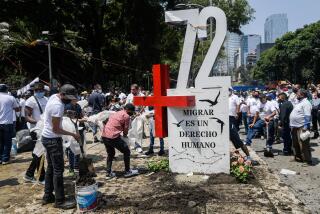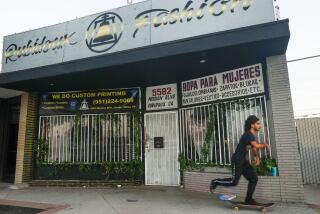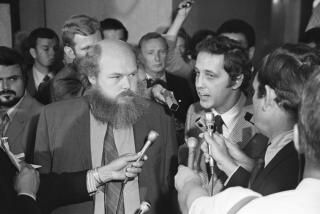Defendant in notorious ’42 Sleepy Lagoon murder case was unjustly convicted
Manuel Reyes, a defendant in the infamous 1942 Sleepy Lagoon murder case in which 12 young Mexican American men were unjustly convicted of the murder of a Mexican national and served nearly two years in prison before their convictions were reversed, has died. He was 82.
Reyes, the former owner of a South Los Angeles taco stand, died of cancer Feb. 5 in the Los Angeles home of his eldest son, Manuel, said Mario Reyes, his youngest son.
A Los Angeles native who dropped out of high school in the 10th grade and began helping his uncle on his garbage-collecting route, Reyes was 17 when he was arrested in connection with the murder of Jose Diaz, a young farmworker who died Aug. 2, 1942, after being found brutally beaten and stabbed at a ranch in Montebello.
Reyes was among 24 young Mexican American men who were charged in the case, and the ensuing trial of 22 of them became one of the largest mass trials in American history.
“My dad just told me he was guilty by association because they were Hispanic,” said Mario Reyes. “He said they just rounded up a bunch of Mexicans and let some go. He never went into details about anything that happened that night.”
Some of the defendants, according to trial testimony, had been assaulted by a gang called the Downey Boys earlier in the night at a reservoir dubbed Sleepy Lagoon, after a popular song of the day.
When they and other young men from their 38th Street neighborhood later returned to the reservoir to retaliate, the Downey gang was gone. They then crashed a birthday party at the nearby ranch, where, according to testimony, some of the defendants demanded to know the whereabouts of the “men who had beaten them up.”
After some of the 38th Street boys entered the house, a fight broke out.
After the intruders had departed, Diaz was found lying unconscious in the dirt outside the fence south of the house.
The trial, which raised constitutional issues and continues to be cited today when appeals are made on the basis of an unfair trial, has been called “one of the darkest chapters in Los Angeles court history.”
While being held in Los Angeles County Jail, the 22 defendants were denied haircuts, and they were not allowed a change of clothes during the first month of the 13-week trial.
When defense attorneys objected that the unkempt “boys looked like mobsters, like disreputable persons,” Judge Charles W. Fricke ruled against the motion.
The judge also ignored defense attorneys’ objections to the courtroom’s seating arrangements: Rather than sitting next to their lawyers, the defendants sat in two rows of seats facing the jury, which prevented them from consulting with their attorneys during the proceedings.
Jurors also were allowed to go home at night and had access to the frequently sensationalistic media coverage of the trial, as well as stories on juvenile delinquency that focused on Mexican American gang members.
The all-white jury found three of the defendants guilty of first-degree murder; nine, including Reyes, were found guilty of second-degree murder. Five other defendants were convicted of assault, and five were acquitted.
Carey McWilliams, a noted advocate for social justice, headed the Sleepy Lagoon Defense Committee to publicize the injustice of the trial and to raise money to fund the appeal.
“It was a racist trial,” Alice Greenfield McGrath, who was present at the trial and served as the committee’s executive secretary, told The Times this week. “The judge was unfailingly supporting the prosecution and on many instances was even insulting the defense attorneys.”
After 12 of the defendants were sent to San Quentin State Prison, McGrath kept them updated on committee activities and visited them about every six weeks. She remembered Reyes being “one of the quieter ones -- a few of them had pretty interesting personalities -- and he was a pleasant person. He was never in any kind of trouble before or after.”
In October 1944, the 2nd District Court of Appeal reversed all the convictions, citing insufficient evidence to show that the defendants had conspired to commit the crimes and saying that there was “no evidence to show that any of the defendants murdered the deceased.”
The court also said the trial judge was “guilty of prejudicial misconduct in making undignified and intemperate remarks” to the defendants’ counsel and admonished the judge for providing inadequate seating arrangements that isolated the defendants.
Soon after, a Superior Court judge dismissed the charges.
The last time McGrath saw Reyes was in 1997 when he and other surviving defendants met in El Monte for a reunion to celebrate McGrath’s 80th birthday.
Then 71, Reyes could still recite his prison number: 69597.
“I wasn’t ‘Mr. Reyes’ or ‘Punk,’ ” he said. “I was a number.”
Two decades earlier -- in 1979 -- Reyes had joined the seven other surviving defendants in an invasion of privacy suit against writer-director Luis Valdez and others involved in the production of Valdez’s critically acclaimed play “Zoot Suit,” which was inspired by the Sleepy Lagoon murder case.
An out-of-court settlement resulted in the eight men being awarded financial participation in performances of the play and 1% of the net profits of the ensuing film to be divided among them, their lawyer, Paul Fitzgerald, said in 1981.
It was not until the suit was filed, Mario Reyes said, that he and his siblings learned that their father had been involved in the case.
“We had no clue,” he said. “My dad was very quiet about his growing up. We never knew anything” until the suit “started to surface. He said, ‘I might as well tell you; it’s going to come out anyway.’ ”
Reyes was born in Los Angeles on July 13, 1925. After he was released from prison, he served stateside in the Army during World War II.
He held a variety of jobs, working as a tailor, a shop steward in a warehouse and a truck driver, before he and his wife, Maria, opened El Taco Mexicano in South Los Angeles in 1958.
Reyes’ son Manuel took over the taco stand in 1969. In 2002, it was taken over by Mario Reyes, who still owns it.
In addition to his sons Manuel and Mario, Reyes is survived by another son and a daughter; a brother, two sisters and six grandchildren.
--
More to Read
Sign up for Essential California
The most important California stories and recommendations in your inbox every morning.
You may occasionally receive promotional content from the Los Angeles Times.










